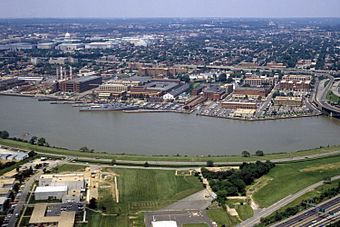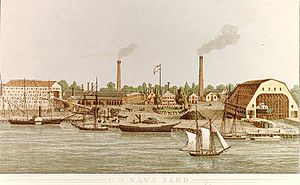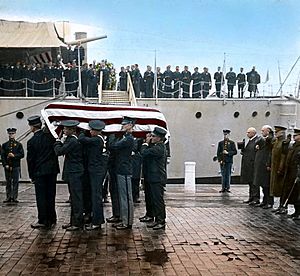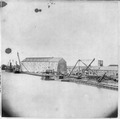Washington Navy Yard facts for kids
Quick facts for kids |
|
|
Washington Navy Yard
|
|

Aerial view of Washington Navy Yard, 1985
|
|
| Lua error in Module:Location_map at line 420: attempt to index field 'wikibase' (a nil value). | |
| Location | Washington, D.C. |
|---|---|
| Built | 1799 |
| Architect | Benjamin Latrobe; Et al. |
| Architectural style | Colonial Revival Late Victorian |
| NRHP reference No. | 73002124 |
| Added to NRHP | June 19, 1973 |
The Washington Navy Yard is a very old and important place for the United States Navy. It used to be a place where ships were built and weapons were made. Today, it's a special center for the U.S. Navy in Southeast Washington, D.C..
Many important Navy offices are located here. These include the offices of the Chief of Naval Operations and the Naval Sea Systems Command. It also houses the Naval Historical Center, which helps keep track of Navy history. The United States Navy Band is also based here. The Washington Navy Yard became a National Historic Landmark in 1976.
Contents
The Washington Navy Yard has a long and interesting history. It played a big role in both military events and scientific discoveries.
Early Days and Military Role
The land for the Navy Yard was bought in 1799. The Yard officially opened on October 2, 1799. This makes it the oldest shore base of the U.S. Navy. Benjamin Stoddert, the first Secretary of the Navy, helped set it up. Commodore Thomas Tingey was its first leader for 29 years.
The original walls built in 1800 are still there today. They are white brick walls on the north and east sides. The Latrobe Gate, built in 1809, is a famous entrance. The Anacostia River formed the southern edge of the Yard. More land was added over time by filling in marsh areas.
In its early years, the Washington Navy Yard was a major shipbuilding place. They built 22 ships, from small gunboats to large steam frigates like the USS Minnesota. The famous USS Constitution came here in 1812 for repairs before going into battle.
The War of 1812 and Beyond

During the War of 1812, the Navy Yard was very important. It helped protect Washington, D.C., from the British. Sailors from the Yard fought bravely against the British forces.
When the British marched into Washington, the Yard's leader, Commodore Tingey, ordered it to be burned. This was to stop the enemy from capturing its valuable supplies. Tingey's own house and the Latrobe Gate were saved from the fire.
After the War of 1812, the Navy Yard stopped being a main shipbuilding center. The Anacostia River was too shallow for bigger ships. So, the Yard changed its focus to making weapons and new technology. It had one of the first steam engines in the United States. It made things like anchors and chains for Navy ships.
Civil War and New Technologies

During the American Civil War, the Yard was again vital for defending Washington. President Abraham Lincoln often visited the Yard. The famous ironclad ship USS Monitor was repaired here after its historic battle.
After the war, the Yard continued to be a place for new inventions. In 1886, it became the main center for making all Navy weapons. It produced weapons for the Great White Fleet and for the Navy during World War I. Even huge railway guns used in France during World War I were made here.
By World War II, the Washington Navy Yard was the biggest naval weapon factory in the world. Weapons designed and built here were used in many wars until the 1960s. At its busiest, almost 25,000 people worked there. They made everything from small optical parts to giant battleship guns.
In 1945, the Yard was renamed the U.S. Naval Gun Factory. Weapon making slowly stopped in 1961. In 1964, it became the Washington Navy Yard again. The old factory buildings were turned into offices.
The Washington Navy Yard was recognized as a historic place in 1973. It was named a National Historic Landmark in 1976.
Scientific and Cultural Achievements
Many important scientific discoveries happened at the Washington Navy Yard. Robert Fulton worked on his clockwork torpedo here. In 1822, John Rodgers built the country's first marine railway for fixing large ships. John A. Dahlgren created his special bottle-shaped cannons.
In 1898, David W. Taylor built a ship model testing basin. This was used to test how new ship designs moved in water. The first shipboard aircraft catapult was tested in the Anacostia River in 1912. A wind tunnel was also built here in 1916. Even the giant gears for the Panama Canal locks were made at the Yard.
The Washington Navy Yard was also a place for important ceremonies. In 1860, the first Japanese diplomats were welcomed to the U.S. here. The body of the Unknown Soldier from World War I arrived here. Charles A. Lindbergh returned to the Navy Yard in 1927 after his famous flight across the Atlantic Ocean. In 1939, King George VI of Britain visited the Yard.
Today, the Navy Yard is home to many Navy activities. It is the main office for the Naval District Washington. The Navy Museum is also here. It has many naval art and artifacts that show the Navy's history. The destroyer USS Barry is a museum ship at the Yard. Visitors can explore it and learn about Navy life.
Current Operations
The Washington Navy Yard is now a center for Navy administration and ceremonies. It is the home of the Chief of Naval Operations. It also houses the headquarters for the Naval Sea Systems Command and the Naval Criminal Investigative Service. Many other important Navy groups, like the United States Navy Band, are based here.
Related pages
- Building 170
Images for kids
See also
 In Spanish: Astillero Naval de Washington para niños
In Spanish: Astillero Naval de Washington para niños




